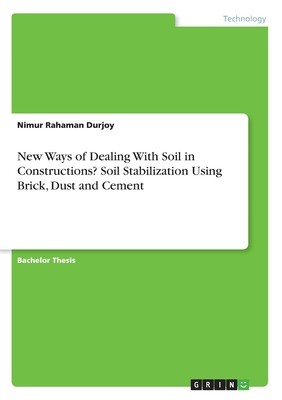
- We will send in 10–14 business days.
- Author: Nimur Rahaman Durjoy
- Publisher: GRIN Verlag
- ISBN-10: 3346244342
- ISBN-13: 9783346244345
- Format: 14.8 x 21 x 0.3 cm, minkšti viršeliai
- Language: English
- SAVE -10% with code: EXTRA
New Ways of Dealing With Soil in Constructions? Soil Stabilization Using Brick, Dust and Cement (e-book) (used book) | bookbook.eu
Reviews
Description
Bachelor Thesis from the year 2019 in the subject Engineering - Geotechnology, grade: A, language: English, abstract: The nature of soil is an ambiguous property unlike it is treated to know the basic engineering parameters. Usually, soil and soft soils cause difficulties in construction site when having low strength and low stiffness. To enhance the engineering property, soil needs to be stabilized. This study is an experimental base research where brick dust and cement are used to stabilize the soil to explore the more uses of raw materials like this as well as to improve the quality of soft soil at the proposed site of Manikdi, Dhaka. The soil is classified as a clayey soil and determined the plastic limit, liquid limit, specific gravity, grain size. Secondly, to compare the strength and characteristics of existing soil before and after treating with the combination of brick dust and cement. We used two different mixed ratio and natural soil to conduct this experiment. From unconfined compression strength test of natural soil, soil with mix ratio (Cement: Brick Dust: Soil=1:1.5:7) and soil with mixed ratio (Cement: Brick Dust: Soil=1:2:7) were 483.7 kPa, 737.2 kPa and 967.8 kPa consequently. So, we found that the stress is increasing with increasing amount of cement and brick dust. From The grain size analysis, the Cu value of natural soil, soil with mix ratio (Cement: Brick Dust: Soil=1:1.5:7) and soil with mixed ratio (Cement: Brick Dust: Soil=1:2:7) were 4.3, 5.06 and 3.25 consequently. Also we found that the Cc value of natural soil, soil with mix ratio (Cement: Brick Dust: Soil=1:1.5:7) and soil with mixed ratio (Cement: Brick Dust: Soil=1:2:7) were 0.84, 0.879 and 0.83 consequently. So for this three cases the soil sample was poorly graded. From the Atterberg limit test the liquid limit for natural soil, soil with mix ratio (Cement: Brick Dust: Soil=1:1.5:7) and soil with mixed ratio (Cement: Brick Dust: Soil=1:2:7) were 36.07%, 34.63% and 33.17% conseq
EXTRA 10 % discount with code: EXTRA
The promotion ends in 23d.05:48:18
The discount code is valid when purchasing from 10 €. Discounts do not stack.
- Author: Nimur Rahaman Durjoy
- Publisher: GRIN Verlag
- ISBN-10: 3346244342
- ISBN-13: 9783346244345
- Format: 14.8 x 21 x 0.3 cm, minkšti viršeliai
- Language: English English
Bachelor Thesis from the year 2019 in the subject Engineering - Geotechnology, grade: A, language: English, abstract: The nature of soil is an ambiguous property unlike it is treated to know the basic engineering parameters. Usually, soil and soft soils cause difficulties in construction site when having low strength and low stiffness. To enhance the engineering property, soil needs to be stabilized. This study is an experimental base research where brick dust and cement are used to stabilize the soil to explore the more uses of raw materials like this as well as to improve the quality of soft soil at the proposed site of Manikdi, Dhaka. The soil is classified as a clayey soil and determined the plastic limit, liquid limit, specific gravity, grain size. Secondly, to compare the strength and characteristics of existing soil before and after treating with the combination of brick dust and cement. We used two different mixed ratio and natural soil to conduct this experiment. From unconfined compression strength test of natural soil, soil with mix ratio (Cement: Brick Dust: Soil=1:1.5:7) and soil with mixed ratio (Cement: Brick Dust: Soil=1:2:7) were 483.7 kPa, 737.2 kPa and 967.8 kPa consequently. So, we found that the stress is increasing with increasing amount of cement and brick dust. From The grain size analysis, the Cu value of natural soil, soil with mix ratio (Cement: Brick Dust: Soil=1:1.5:7) and soil with mixed ratio (Cement: Brick Dust: Soil=1:2:7) were 4.3, 5.06 and 3.25 consequently. Also we found that the Cc value of natural soil, soil with mix ratio (Cement: Brick Dust: Soil=1:1.5:7) and soil with mixed ratio (Cement: Brick Dust: Soil=1:2:7) were 0.84, 0.879 and 0.83 consequently. So for this three cases the soil sample was poorly graded. From the Atterberg limit test the liquid limit for natural soil, soil with mix ratio (Cement: Brick Dust: Soil=1:1.5:7) and soil with mixed ratio (Cement: Brick Dust: Soil=1:2:7) were 36.07%, 34.63% and 33.17% conseq


Reviews